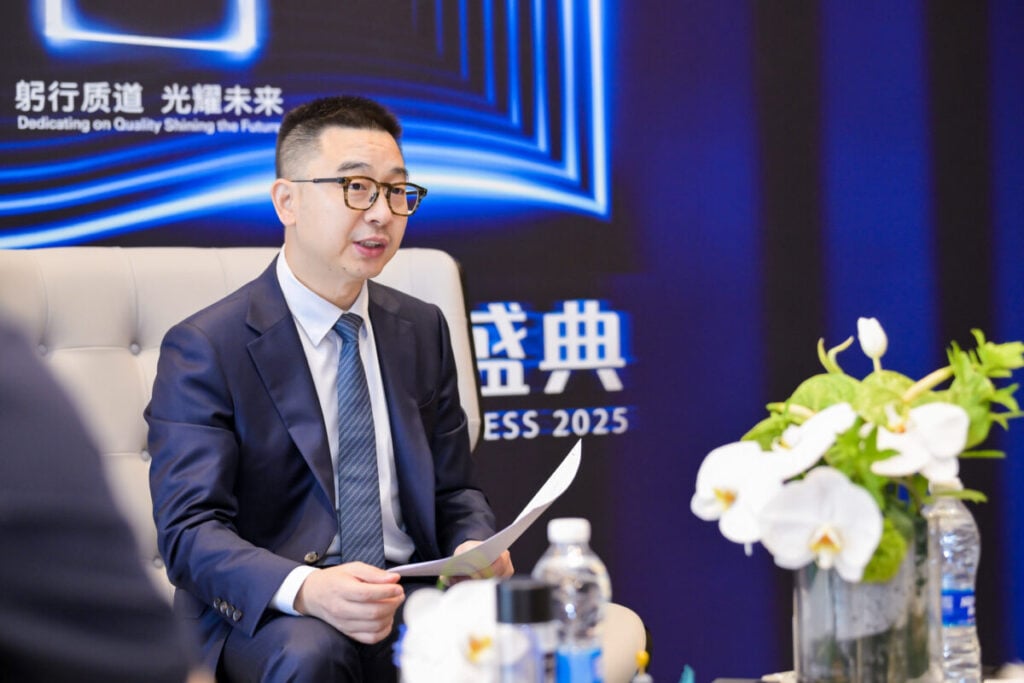
In a recent interview with PV Tech, Dennis She, vice president of LONGi, delved into core issues such as high-quality development in the PV industry, the mass production and shipment of back contact (BC) technology and the construction of the BC ecosystem. He provided an in-depth analysis of the value logic behind LONGi’s strategic focus on the BC technology roadmap.
BC technology emerges as the definitive direction
Amidst the rapid development and competition of n-type technologies, She believes the PV industry should engage in healthy competition centred on “efficiency.” Whether it’s BC, TOPCon or perovskite, technological progress under unified standards is what truly drives industry upgrades.
Try Premium for just $1
- Full premium access for the first month at only $1
- Converts to an annual rate after 30 days unless cancelled
- Cancel anytime during the trial period
Premium Benefits
- Expert industry analysis and interviews
- Digital access to PV Tech Power journal
- Exclusive event discounts
Or get the full Premium subscription right away
Or continue reading this article for free
“We do not deny the value of TOPCon, but BC has a clear advantage in power generation capability,” VP She stated. He cited data suggesting that compared to mass-produced TOPCon modules, BC modules boast an absolute efficiency advantage of 5% (approximately 30W more power) and offer an additional 2-3% power generation per watt. This results in a comprehensive power generation lead of 7-8%. This advantage stems from BC technology’s lower degradation rate, better performance in low-light conditions and stronger resistance to hot spots, which directly translates into improved return on investment for customers.
LONGi has also outlined a clear BC product pathway for different scenarios. “The rooftop and distributed markets should fully adopt BC, as its efficiency, safety, and aesthetics perfectly match market needs,” She said. For utility-scale markets, the adoption depends on TOPCon’s ability to further improve efficiency. “TOPCon may still have its space in scenarios highly sensitive to cost and with lower demands for power generation gain, such as certain desert projects. BC is not seeking a 100% replacement rate”. In the long run, as customers pay increasing attention to long-term returns, the market share of BC will gradually expand.
“Regarding quality, LONGi has consistently opposed ‘thinner glass’ and simply ‘larger modules’,” he emphasised. LONGi previously launched Ice-Shield modules (with front glass maintained at 3.2mm) in the US, European and Australian markets. Customers using these products can benefit from lower premiums and obtain insurance coverage.
LONGi is collaborating with authoritative bodies like TÜV Rheinland and CQC to promote the establishment of higher industry quality standards. “PV products have a lifecycle of up to 30 years. We cannot compromise long-term value for short-term market pressure. High standards are essential for the healthy development of the industry,” he stressed.
Building a BC ecosystem
Since May 2025, LONGi has been commissioning a new BC production line every week and is close to achieving its year-end target of 50GW BC capacity. All first-generation BC products have been upgraded to the second generation. BC modules are expected to account for about 30% of total module shipments this year, and this proportion is continuously increasing.
“The market has fully accepted BC technology,” VP She pointed out. On one hand, LONGi’s seven years of dedicated BC R&D, sharing R&D data and outdoor empirical data with customers, coupled with its reputation for technological innovation, have alleviated customer doubts. On the other hand, from 2024 to the first half of 2025, customers verified BC’s capabilities through real power generation data, which exceeded expectations. Financial models clearly demonstrate the technology’s positive impact on investment returns.
“A PV project has a 30-year lifecycle. It’s even more crucial to choose products with strong long-term power generation capability. A slight short-term cost increase can be exchanged for significant long-term revenue improvement,” She stated. He added that intensified industry competition makes new technology the only breakthrough, and BC’s advantages will become more pronounced as market rationality returns.
Beyond iterating its own BC technology, LONGi is also building a BC ecosystem and establishing norms for technology usage. This initiative aims to foster a healthy innovation environment. The core logic of the ecosystem is to “let innovators see returns” – LONGi provides partners with technical specifications and support, while ensuring reasonable returns on innovation through appropriate mechanisms, promoting a virtuous cycle of “R&D-implementation-profit-further R&D”.
This approach aligns with LONGi’s vision of “becoming the most valuable solar technology company”. “The core of ‘most valuable’ is customer value, which requires long-term verification,” VP She explained. “It involves adhering to the bottom line of quality and technology while also driving the growth of the industry ecosystem, not just focusing on our own development.”
Throughout the interview, Dennis She repeatedly emphasised “long-termism” – LONGi’s choice to invest in BC technology R&D, promote the establishment of industry standards, and explore emerging markets essentially uses “long-term value” to counter “short-term competition”. The accelerated adoption of BC technology is not only a strategic choice for LONGi but also reflects leading companies’ pursuit of solutions for industry transformation.
As She remarked, competition in the PV industry will ultimately return to the essence of technology and quality. LONGi’s exploration undoubtedly provides a crucial reference for this path.






